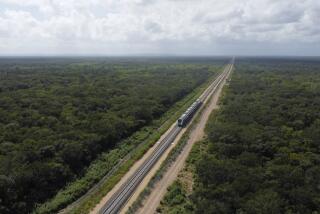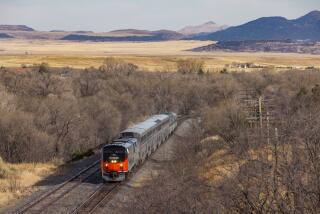Choo-Choo Special : Romancing the Rails : Train Travel is back. But can it ever be the same?
- Share via
Last month, on the day American and coalition forces entered Iraq and Kuwait to begin the ground war, I took a short detour on the way home from my office in Phoenix. Negotiating my way through downtown streets being prepared for Formula One auto racing, I finally was able to join up with several hundred other people who had managed to find their way to one of the most inaccessible places in town--Union Station--to see a train.
Not that it was any old train, mind you. This was the steam-engine-pulled passenger train of the Grand Canyon Railway. The day before, the sight of this iron horse chugging its way down the tracks through West Phoenix had caused gridlock--and no doubt unbelievable delight.
That a working steam engine and its restored passenger cars could draw such a crowd is no surprise. After all, the Grand Canyon Railway has been a tremendous success since it began operating last year on tracks that hadn’t seen a passenger train since Santa Fe ended service to the national park in the 1960s.
What was surprising were the number of people waiting in line to make their way through the Amtrak Superliner cars that had been brought in for a special promotion called “Union Station Days,” or gawking at a brand-new Santa Fe freight locomotive, decked out in the red, gold and silver livery so familiar to a generation of long-ago rail passengers.
Is there something going on here? Is America rediscovering its love affair with trains?
I think not. I choose to believe that America never lost its love affair with railroading. It was the railroads that jilted us. And like all lovers spurned, those of us who count the sound of a train whistle in the night as one of our blessings are getting what we wanted the most: revenge.
We again have trains to ride. Not the New York-to-Chicago 20th Century Limited, sadly, unless we’re catching an old rerun of Cary Grant and Eva Maria Saint in “North by Northwest” on TV. Not the Super Chief, the epitome of elegance between Chicago and Los Angeles. Not any number of great passenger trains that used to cross this country (and Canada, too).
But Amtrak, particularly here in the West, can sometimes provide a reasonablefacsimile thereof. Its first-class service is almost as good as its name implies, but book months ahead if you want to use it. Coaches are comfortable, although usually crowded. And the food will do. My favorites: the Sunset Limited between L.A. and New Orleans, a two-day leisurely jaunt through what is left of the American West, and the Coast Starlight, a dream run from L.A. to Seattle past California beaches and through the Cascades of Oregon.
More importantly, we now have entrepreneurs who are convinced that railroads can haul people and still make a buck. They can be found running trains such as the Grand Canyon Railway (from Williams, Ariz., to the South Rim now, with ambitious talk of L.A. to the canyon in the not-too-distant future).
The Grand Canyon is just one of what has become a new phenomenon in railroading--the so-called “cruise” train. Actually, this form of railroading has been around for a long time (the Skunk Line through the redwoods of Northern California being just one example), but it’s been only recently that the idea has been so successfully exploited. Now it’s called the leisure train industry, and the focus, both here and in Europe, generally is on providing luxury train travel, even if the train is really only going in circles.
Although some cruise trains have gone bust (Princess Tours’ L.A.-Oakland California Sun Express lasted only four months), this idea may be the most promising development in passenger railroading since the dome car.
Other hopeful signs are the continued use of excursion trains, usually as public relations promotions by the railroads themselves. The Norfolk and Southern runs such specials along its Southeastern U.S. network, pulled by steam engines that some executive had the sense to save and keep in working order. As part of Oklahoma’s “Home-coming 90” celebration last year, the Burlington Northern put on two special trains.
In Europe, the glamour of touring the Continent in sumptuously refurbished old cars has given rise to the Royal Scotsman, the Andalusian Express and the comeback of the Orient Express.
And in many American cities, even the urban railway systems abandoned after World War II are making a comeback (L.A.’s light-rail Blue Line and the Metrorail subway marking just the latest manifestation of this renewal).
So training, in one form or another, is back. But will it ever be the same? Again, I think not.
I spent my boyhood in Winfield, Kan., and every summer night--and many a winter night as well--I would pester my mother to take me down to the station to await the arrival of the Texas Chief, the Santa Fe’s crack streamliner between Houston and Chicago. The Texas Chief was quite simply the most magnificent train I have ever seen: long and silver, its shark-nosed engines humming, its bell engine and its headlight revolving as it pulled into the depot for what must have been no more than a four- to five-minute stop.
This was a train that continued to meet Santa Fe’s demanding standards of excellence up until the day in the early 1970s when the National Railroad Passenger Corp. (Amtrak) went into the rail passenger business, and the Santa Fe and most other American lines went out.
But even in those days when I so anxiously awaited its every arrival, the Texas Chief was a doomed train. That was the 1950s, and the railways were already beginning to pull passenger trains off their schedules as soon as they could make the case for federal approval to do so. An early casualty, I noticed, was the Little Ranger, a self-propelled “doodlebus” that worked its way through the Flint Hills of Kansas. Others followed, usually just “locals” that most people didn’t care about, but the pattern was clear.
I remember asking one railroading authority (my uncle, a Rock Island engineer and high official in the engineers’ union) why this was happening. He told me that the big guys in Chicago (all railroad big guys were in Chicago in those days) thought they could make more money hauling freight. He was right, and of course the freight-hauling business has been a profitable one for many lines. Still, I get a particularly heinous sense of gratification that many of these railroads, including the Rock Island, went under years after they had jettisoned passenger service.
While the Santa Fe tried to retire its trains with some degree of class, other railroads did so with gall: conductors became surly, service nonexistent, trains dirty and, worse, they sometimes wouldn’t move. (I once was stuck on a Rock Island train that took more than four hours to cover the 50 miles from Kansas City to Topeka, Kan., after leaving Kansas City five hours late! Today, Amtrak’s Orange County-San Diego service and the notoriously late Coast Starlight are still major irritants.)
But what really spelled the demise of the passenger trains had nothing to do with freight, and everything to do with travel economy: the delivery in the early 1960s of the first Boeing 707 jet airliners. Suddenly you could fly from New York to Los Angeles in a matter of hours. I don’t think the big guys in Chicago ever anticipated that revolution, but they sure were helped by it. By the late ‘60s, they had convinced the post office to cancel the railway mail contracts, and that was essentially it.
I took my first Amtrak trip in 1973, and it was--well, let’s say it was primitive. (So primitive, in fact, that the continuation of my journey on N de M, National Railways of Mexico, seemed as though we had left the Third World behind.)
Not even Amtrak in its wretched infancy could kill off the desires of many travelers to have something under them besides 40,000 feet of air. And in 1979, the Ayatollah Khomeini did all railroad travelers a favor when, by coming to power in Iran, he brought on the second oil shock of that decade. Amtrak trains started running full. Today the problem is not too much Amtrak, but not enough.
Still, there’s a long way to go, and thus my pessimism.
Rail passenger service works best when the passenger has a good number of choices as to which train to take. Since the railroads are still committed to freight, I don’t see a day returning when choice is an option.
Secondly, the long-suffering rail traveler often cites the European model when asking why America can’t have superior trains again. But European trains are government-run and they, too, suffer some of the same problems that American railways went through years ago. While the French have the spectacular TGV, which travels at speeds up to 180 m.p.h., other European lines are getting shopworn and thus less attractive. Railways were the crowning achievement of Victorian England; British trains today lumber along, and the service is nonchalant at best. Once the European Community deregulates air fares (surely today the highest in the world), watch for more deterioration in European rail service.
Steamship operators saw time passing them by and turned it into a plus, converting their passenger liners into the cruise ships that have become so popular today. This expansion in leisure training may mean that railroaders have also discovered one truth: Adventure and good service can bring on the customers, even if the train isn’t going anyplace.
This may be our future. I, for one, will take it.
More to Read
Sign up for The Wild
We’ll help you find the best places to hike, bike and run, as well as the perfect silent spots for meditation and yoga.
You may occasionally receive promotional content from the Los Angeles Times.






